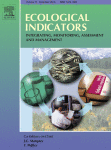Ver ítem
- xmlui.general.dspace_homeCentros Regionales y EEAsCentro Regional Buenos Aires SurEEA BalcarceArtículos científicosxmlui.ArtifactBrowser.ItemViewer.trail
- Inicio
- Centros Regionales y EEAs
- Centro Regional Buenos Aires Sur
- EEA Balcarce
- Artículos científicos
- Ver ítem
An integrative index of Ecosystem Services provision based on remotely sensed data
Resumen
We present an approach to generate estimates and to map Ecosystem Services (ES) related to C and water dynamics (Soil Carbon sequestration, evapotranspiration and groundwater recharge) and biodiversity (Avian Richness) from remotely sensed data in two ecoregions of South America: the Semiarid Chaco woodlands and the Rio de la Plata grasslands. Two attributes of the seasonal dynamics of the Normalized Difference Vegetation Index (NDVI); the annual mean
[ver mas...]
We present an approach to generate estimates and to map Ecosystem Services (ES) related to C and water dynamics (Soil Carbon sequestration, evapotranspiration and groundwater recharge) and biodiversity (Avian Richness) from remotely sensed data in two ecoregions of South America: the Semiarid Chaco woodlands and the Rio de la Plata grasslands. Two attributes of the seasonal dynamics of the Normalized Difference Vegetation Index (NDVI); the annual mean (NDVI mean), an indicator of light interception and hence of total C gains and the intra-annual Coefficient of Variation of the NDVI (NDVI CV), a descriptor of seasonality; were combined into an ES provision index (ESPI = NDVImean * (1-NDVICV)). The proportion of the variance in ES provision explained by the ESPI varied from 0.484 for avian richness up to 0.662 for C sequestration. A relatively large proportion of the studied area presented changes in ES provision. A 32,4% of the Semiarid Chaco and the Rio de la Plata grasslands presented significant (p < 0.01) trends. Most of the trends (30.2%) were negative, showing a decrease in ESPI. An index like the one proposed here can be used as an aggregated indicator of the status and/or trends of ES supply at large spatial scales (subcontinental in our case).
[Cerrar]

Autor
Paruelo, José María;
Texeira González, Marcos Alexis;
Staiano, Luciana;
Mastrangelo, Matías Enrique;
Amdan, María Laura;
Gallego, Federico;
Fuente
Ecological Indicators 71 : 145-154 (December 2016)
Fecha
2016-12
Editorial
Elsevier
ISSN
1470-160X
Formato
pdf
Tipo de documento
artículo
Palabras Claves
Derechos de acceso
Restringido
 Excepto donde se diga explicitamente, este item se publica bajo la siguiente descripción: Creative Commons Attribution-NonCommercial-ShareAlike 2.5 Unported (CC BY-NC-SA 2.5)
Excepto donde se diga explicitamente, este item se publica bajo la siguiente descripción: Creative Commons Attribution-NonCommercial-ShareAlike 2.5 Unported (CC BY-NC-SA 2.5)

